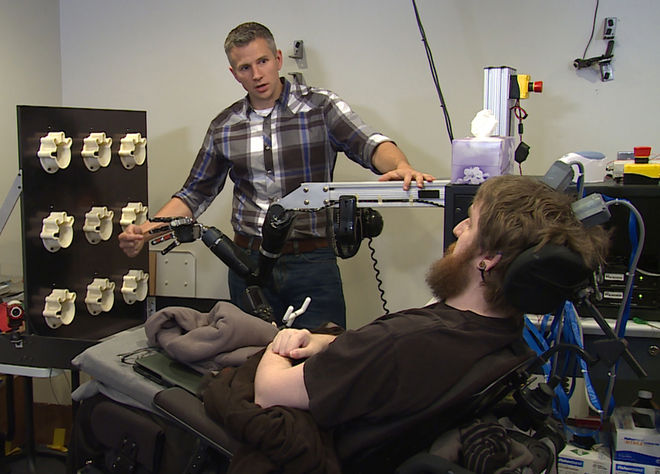An electronic implant has enabled a spinal injury patient to experience sensations from his hand for the first time since his injury a decade ago.
Injuries to the spinal cord are devastating. Patients are frequently left paralysed and without sensation over most of the body, and the prospects for recovery can be quite poor because damaged nerves in the brain and spinal cord do not regenerate spontaneously.
Scientists have made significant strides forward in recent years in helping paralysis victims to regain control of their bodies by engineering implants that can eavesdrop on the neurological chatter that goes on in the brain's movement centres and then translate this conversation into meaningful movements of prosthetic or robotic devices.
Patients uses these devices by learning to think along the right lines. But in all these cases, although a patient can make something move, he or she still lacks a sense of touch, which can be doubly crippling because it can make manipulating objects with a prosthesis very difficult because it is hard to judge how much force is being applied.
Most normal people also take for granted the huge amount we learn when we run a fingertips over something. Now neuroscientist Robert Gaunt and his colleagues at the University of Pittsburgh have take a step towards returning a sense of touch to paralysed patients by developing a network of tiny implantable electrodes that send sensory messages into the underlying tissue.
The electrodes sit in the brain's sensory area and use small bursts of electrical current to trigger the underlying nerve cells to fire impulses that in turn are interpreted by the conscious brain as a sensory experience.
Gaunt and his team have been working with a patient who suffered a spinal injury about a decade ago. The patient underwent a surgical procedure more than a year previously to implant the electrode array into his somatosensory cortex, which sits just behind the front half of the brain.
The somatosensory cortex is organised like a map of the body, with different parts of the anatomy represented in different regions of the brain surface. The electrodes the team implanted went into the area corresponding to one of his hands.
When small (sixty microamp) electrical currents were applied to the electrodes the patient was able to "feel" sensations that appeared to be coming from his hand. He described the sensations as feeling like "pressure", or tapping, buzzing or "electricity".
And by stimulating different parts of the electrode array, it was possible to elicit sensations in different parts of the patient's hand.
Critically, the sensations were not painful, because pain is interpreted in a different region on the brain, which was not stimulated during these experiments. But the results show that meaningful sensations can be elicited and appear to come from the correct body part.
"This patient has not felt anything from this part of his body for ten years," says Gaunt. "But the signals we supplied produced sensations that felt normal to the subject. That shows that the underlying wiring in the brain is still intact."
The challenge now facing the team is to extend the resolution of their electrode array so that they can cover a more extensive body territory, and discover how to make the sensations they are able to elicit as meaningful as possible for the patient. "This is just a first step!" Gaunt cautions.










Comments
Add a comment